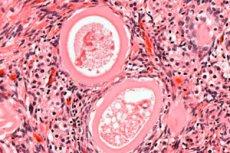Multifollicular ovaries and pregnancy
Last reviewed: 18.10.2021

All iLive content is medically reviewed or fact checked to ensure as much factual accuracy as possible.
We have strict sourcing guidelines and only link to reputable media sites, academic research institutions and, whenever possible, medically peer reviewed studies. Note that the numbers in parentheses ([1], [2], etc.) are clickable links to these studies.
If you feel that any of our content is inaccurate, out-of-date, or otherwise questionable, please select it and press Ctrl + Enter.

One of the most common symptoms of MFN is a disorder of the menstrual cycle, which entails problems with conception. Hormonal imbalance and lack of luteinizing hormone disrupt the process of ovulation, so the cycles alternate. A large number of structural elements in the appendages leads to the fact that they do not have time to ripen or the simultaneous appearance of several dominant follicles.
To treat this condition and restore reproductive functions, hormone therapy is used. Patients are prescribed drugs from the group of oral contraceptives, which eliminate imbalance. This allows the follicles to develop normally and exit the ovule during the ovulation period, increasing the chances of successful conception.
That is, multifollicular ovaries and pregnancy are compatible. Problems can arise in the processes of bearing a child. This is due to the fact that a large number of follicles provokes increased production of hormones, which can lead to spontaneous abortion. To prevent this complication, women are prescribed progesterone preparations and conduct regular studies to monitor the condition of the fetus.
Multifollicular ovaries and infertility
Ovaries are responsible for the reproductive capacity of women. In them, follicles ripen and ovulation occurs. Violation of the normal functioning of organs leads to various problems, one of which is the impossibility of conception. Such a concept as infertility is applied in the event that after a year of regular unprotected sex, pregnancy has not occurred.
Infertility in multifollicularity is temporary because it is amenable to correction and most often due to such factors:
- Anovulatory cycle.
- Hormonal disorders.
- Endocrine diseases.
- Impaired synthesis of luteinizing hormone.
- Pituitary hypofunction.
After correction of the above factors, the hormonal background normalizes. The menstrual cycle and ovulation are restored, which makes pregnancy possible. If ovulation can not be restored, it indicates that the MFW went into the form of polycystosis, whose treatment is longer and more serious. During pregnancy, women with MFN should be under medical supervision. This is due to the risk of spontaneous miscarriages in the early stages.
The probability of becoming pregnant with multifollicular ovaries
The chances of pregnancy with identified MFN are the same as in healthy women. Multifollicularity is not infertility or life-threatening pathology. It merely indicates certain abnormalities in the functioning of the reproductive organs, which are amenable to correction.
Normally, during the menstrual cycle, the follicles in each ovary mature, which contain the oocytes. The number of such follicles is from 4 to 7, 1-2 of them burst and ovulation occurs. With multifallikulyarnosti the number of structural elements is 8-12 pieces. Because of this, they do not ripen to normal, and ovulation does not occur. Against this background, there are violations of the menstrual cycle and hormonal background, ineffective eggs are produced, which creates problems with conception.
If there are no hormonal failures or any other abnormalities with MFN, then treatment is not performed. In this case, the increased number of follicles is regarded as a variant of the norm. But if ovulation does not occur within 3-4 cycles, then medical consultation and medication correction is required. This is necessary to prepare the body for successful conception and normal pregnancy.
How to become pregnant with multifollicular ovaries?
If, after correcting the violations caused by the MPL, it is not possible to conceive the child for an extended period of time, IVF or other methods of artificial insemination are recommended. Extracorporeal fertilization is an auxiliary reproductive technology that is performed outside the female body. The patient is taken away from the follicles, which are fertilized and inserted into the uterus.
The procedure consists of several stages:
- Stimulation of ovulation.
- Transvaginal superovulation.
- Transfer of embryos.
- Maintenance of the luteal phase.
Difficulties arise during the stimulation of ovulation with MPL. For this purpose, an individual drug regimen is prepared with a clearly selected dosage. Very often, stimulation is carried out several times with the changes in drugs. This increases the risk of developing a hyperstimulation syndrome, which leads to ovarian malnutrition. To prevent this complication, IVF is done after stabilization of all metabolic processes in the body.
Without fail, before artificial insemination of patients with an increased number of structural elements, the gonads are checked for patency of the fallopian tubes. This procedure significantly increases the chances of restoring ovulation. If patency is impaired, IVF is performed with laparoscopy.
Pregnancy twins
Multiple pregnancy with multifollicular ovaries is not uncommon. This occurs when two or more ovulations occur in one cycle and several full-fledged dominant follicles mature. In this case, there are high chances of a twin pregnancy.
The probability of the birth of twins increases significantly when passing IVF. In vitro fertilization can cause both bipartite and monozygotic multiple pregnancies. In the first case twins are born, and in the second twins. The frequency of twin birth in women with MFN is about 11% with IVF - 35-40%.
Multifollicular ovaries after childbirth
One of the reasons for the appearance of MFN after the birth of a child is the lactation period. During breastfeeding, increased production of prolactin is activated, which suppresses ovulation. An increased number of structural elements can also be caused by stress, significant fluctuations in body weight or endocrine diseases.
Multifollicularity is determined by ultrasound. Echocardiograms of MFN are not always accompanied by clinical symptoms. To reduce the risk of developing this syndrome, it is recommended to monitor weight changes, maintain moderate physical exertion and contact the gynecologist with the first painful symptoms in the pelvic organs.

